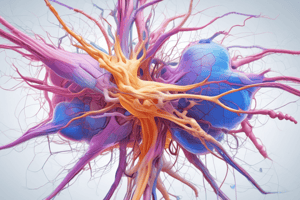Podcast
Questions and Answers
What type of stimuli can excite sensory nerve endings in the skin?
What type of stimuli can excite sensory nerve endings in the skin?
- High temperature
- Electromagnetic waves
- Sound waves
- Mechanical pressure (correct)
Electrical current is used to transmit signals between muscle cells in the heart and intestine.
Electrical current is used to transmit signals between muscle cells in the heart and intestine.
True (A)
What is the result of hyperpolarization in a nerve fiber?
What is the result of hyperpolarization in a nerve fiber?
Decreased excitability
Increasing the voltage of a stimulus can lead to __________ of a nerve fiber.
Increasing the voltage of a stimulus can lead to __________ of a nerve fiber.
Match the following types of excitation with their corresponding mechanisms:
Match the following types of excitation with their corresponding mechanisms:
What happens when a weak negative electrical stimulus is applied to a nerve fiber?
What happens when a weak negative electrical stimulus is applied to a nerve fiber?
The plateau phase in heart muscle occurs due to the influx of sodium ions.
The plateau phase in heart muscle occurs due to the influx of sodium ions.
What is the role of sodium and potassium channels in action potentials?
What is the role of sodium and potassium channels in action potentials?
What happens to the membrane potential during the rising phase of an action potential?
What happens to the membrane potential during the rising phase of an action potential?
The conductance for sodium ions is greater than that for potassium ions in a resting nerve fiber.
The conductance for sodium ions is greater than that for potassium ions in a resting nerve fiber.
What causes the sudden conformation change in sodium channels during an action potential?
What causes the sudden conformation change in sodium channels during an action potential?
During repolarization, the simultaneous increase in _____ exit speeds up the recovery of the resting membrane potential.
During repolarization, the simultaneous increase in _____ exit speeds up the recovery of the resting membrane potential.
Which event occurs immediately after the nerve fiber is excited?
Which event occurs immediately after the nerve fiber is excited?
Describe the role of Na+ ions in the action potential mechanism.
Describe the role of Na+ ions in the action potential mechanism.
Match the phase of action potential to its description:
Match the phase of action potential to its description:
The plateau phase in heart muscle is primarily due to the prolonged influx of potassium ions.
The plateau phase in heart muscle is primarily due to the prolonged influx of potassium ions.
What occurs first during the repolarization of a nerve fiber?
What occurs first during the repolarization of a nerve fiber?
The inactivation gate of Na+ channels remains open until the membrane potential returns to the original level.
The inactivation gate of Na+ channels remains open until the membrane potential returns to the original level.
What is the membrane potential of a neuron at rest?
What is the membrane potential of a neuron at rest?
During repolarization, _ ions can pour outward through the open ______ channels.
During repolarization, _ ions can pour outward through the open ______ channels.
Match the following channels with their characteristics:
Match the following channels with their characteristics:
What characterizes spontaneous rhythmicity in heart muscle cells?
What characterizes spontaneous rhythmicity in heart muscle cells?
The plateau phase in heart muscle is primarily due to the sustained influx of Ca2+ ions.
The plateau phase in heart muscle is primarily due to the sustained influx of Ca2+ ions.
What role do voltage-gated K+ channels have during action potential?
What role do voltage-gated K+ channels have during action potential?
Flashcards are hidden until you start studying
Study Notes
Excitation of Nerve Fibers
- Different mechanisms are utilized to evoke nerve or muscle action potentials, including mechanical, chemical, and electrical stimuli.
- Mechanical pressure stimulates sensory nerve endings in the skin, inducing excitability.
- Chemical neurotransmitters facilitate signal transmission between neurons in the brain.
- Electrical current transmits signals between muscle cells, particularly in the heart and intestine.
Action Potential Mechanism
- A weak negative electrical stimulus may not induce excitation in a nerve fiber until a threshold is reached.
- Increased voltage of the stimulus leads to action potential generation, whereas insufficient voltage causes hyperpolarization, decreasing fiber excitability.
Repolarization Process
- Following the influx of sodium (Na+) ions, Na+ channels close while potassium (K+) channels open, contributing to repolarization.
- The inactivation gate of Na+ channels remains closed until the membrane potential returns to its original state.
Voltage-Gated Channels
- Na+ channels include two gates: activation gate (external) and inactivation gate (internal).
- During the resting membrane potential of -70 millivolts, Na+ entry is prevented as the activation gate remains closed.
- When stimulated, the membrane depolarizes, creating a sudden conformational change that opens Na+ channels, allowing Na+ ions to flow inward.
Resting and Activated States
- The resting potential is at -70 mV, and during activation, the potential rises towards 0 mV, specifically around -55 mV, indicating the threshold.
- Activated Na+ and K+ channels facilitate the flow of ions, drastically affecting membrane permeability.
Propagation of Action Potential
- The initial excitation in a nerve fiber leads to a local circuit where current flows from depolarized to adjacent resting membrane areas.
- Upon reaching new areas, sodium channels promptly open, further amplifying the action potential propagation through the fiber.
- The stabilization of resting membrane potential occurs as the exit of K+ ions increases while Na+ entry decreases, speeding the repolarization process.
Studying That Suits You
Use AI to generate personalized quizzes and flashcards to suit your learning preferences.




